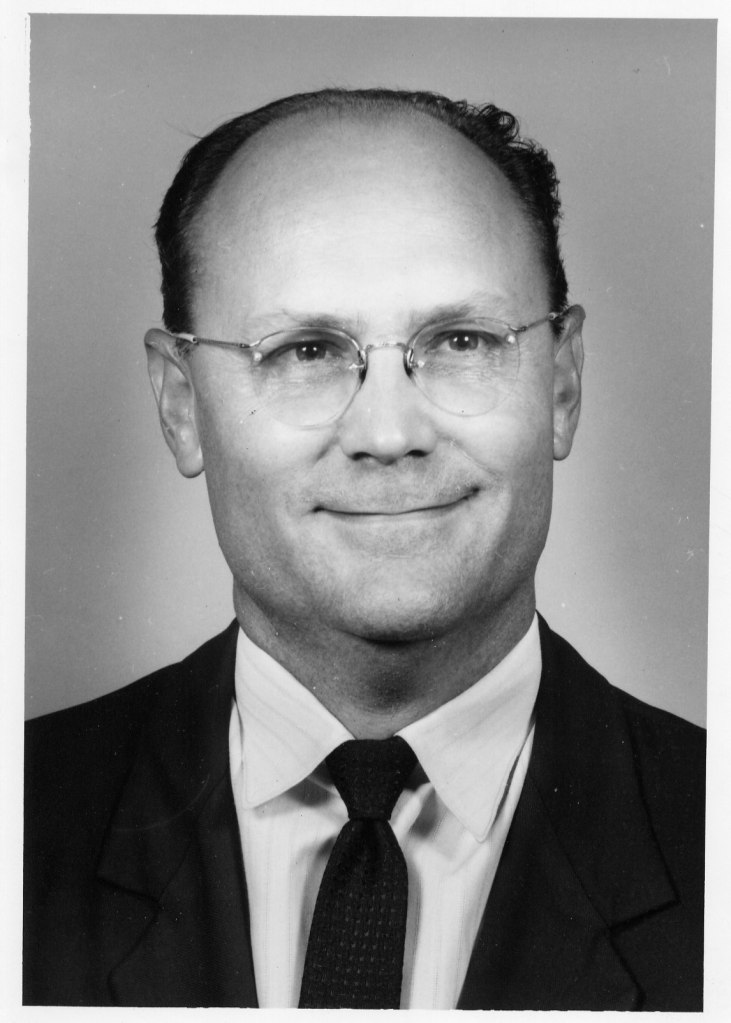I typed up some newspaper articles on my Grandpa.
*

Albert C. Manucy Receives Highest Honor
[1983 St. Augustine Record newspaper, Atlantic Building]
[Photo of Mayor Paul Martz presenting “noted historian” Albert Manucy a proclamation honoring the author during ceremonies held in the City Hall garden]
The highest honor St. Augustine can bestow, the ‘Order of LaFlorida’, went to historian, writer, and heritage native Albert C. Manucy in a ceremony held Monday evening in the garden of City Hall. [also Lawrence Lewis for his restoration program support] In naming Manucy for this honor, city commissioners designated Monday as ‘Albert C. Manucy Day’, noting that he served at the ‘Castillo de San Marcos National Monument’ for 28 years, made “significant contributions to the rehabilitation and current appearance of several other local monuments including Cubo Line, the City Gate, and the casements of the Castillo…”
Manucy’s scholarship, the city’s proclamation continues, “has provided us definite works on St. Augustine architecture including ‘The Building of Castillo de San Marcos’, and ‘The Houses of St. Augustine 1565-1821’; and his historical research “has been acclaimed by his professional peers in Florida history and in historic preservation, and brought honor to the City of St. Augustine by his being selected a Fullbright Scholar in 1962…”
The historian’s scholarship “has shaped the appearance of our historic preservation districts and held the design of new construction to documented architectural details.”; the economy of the city “relies on the distinctive character of our historic preservation areas.”; and Manucy “is beloved and revered by the people whom he has served in his professional and private life…”
Participants in the ceremony, which was coordinated by Sandra Parks Black and hosted by the City of St. Augustine and Lightner Museum, included Mayor Paul Martz; Kenneth Beeson, Historical Architectural Review Board; Dr. William Adams, Historical St. Augustine Preservation Board (HSAPB); Dr. Johns Griffin, St. Augustine Historical Society; Dr. Eugene Lyon, St. Augustine Restoration Foundation Inc.; Phil Genovar, Easter Festival Committee; Altrusa Club; Coralee Pomar, St. Augustine and St. Johns County Chamber of Commerce; Mike Tennant, Castillo de San Marcos; Robert Harper, Lightner Museum; and Kay Huppi, Friends of St. Augustine Architecture. St. Johns County Commissioner Richard L. Parks, a boyhood schoolmate of Manucy’s who now resides in the restored area home in which Manucy was reared, was narrator.
The Order of LaFlorida was established in 1975 by the city commission, as a means of paying tribute to those persons who, over a long period of time, have contributed extraordinary services to the community. Membership is limited to eight living persons, 55 years of age or older, at any one time. Those named earlier are John Bailey [Insurance & HSAPB]; Retired General Henry McMillan [Florida National Guard adjutant general & HSAPB chair]; and the late H.E. Wolfe [preservation business].
*
Al Burt’s Florida
Dwelling On Places
Historians live in fear that ticky-tacky contrived tourist attractions that crowd close to legitimate realities of history will somehow stain the truth. In St. Augustine, Albert Manucy is trying to keep pure the ancient history of that city.
[photo of Al Manucy and his reflection in a window]
Albert Manucy: “You’ve got to preserve it.”
For Albert C. Manucy pieces of the life puzzle fit together in an extra-ordinary way. He had history for a godfather, dedication to craft as an inheritance. Working in the way that distinguished his ancestors, Albert quietly became part of what he devoted his life to studying.
Looking back now, there seemed significance and pattern in every little piece, even the things of his childhood. He was born in the first city of this nation, St. Augustine. As a boy he lived on San Agustin Antiguo’s main street, St. George, and played at the old stone fort, the Castillo de San Marcos.
The threads of his family history are like paths among the diverse nationalities and cultures that have blended and nurtured St. Augustine; a city whose surviving physical heart is Florida’s greatest historic treasure. The first Manucys were Minorcans of Italian ancestry, who came to Florida 215 years ago as indentured servants. They were among the some 600 (out of 1,255) who survived 10 years of turmoil in Dr. Andrew Turnbull’s colony at New Smyrna, and then fled to St. Augustine.
The Minorcans, “A people of remarkable fidelity and courage,” wrote the historian Dr. Michael Gannon, were a distinct presence in the old city. Craftsmen became priests, lawyers, bankers, historians, and more craftsmen. Albert’s father was a barber; his grandfather a cabinet-maker. “These occupations were in the tradition of the Minorcans,” Al said. “My dad, according to all reports we had from his customers, was a craftsman. When he did a hair-cutting job, he made it fit the face; not vice-versa.”
Albert can trace prior generations of Manucys to the Mediterranean isle of Minorca (off the coast of Spain), beginning with his great-grandfather Felipe, and from him to Marcos and Josef, and then to another Marcos. But he does not dwell on genealogy, as some might. Any family’s branches proliferate backward through generations in a geometric regression; and vanity often guides the selection of a direct descendancy. Just 3 generations back, there are 8 lines of choice for each of us.
“My mother was Scotch-Irish and German. I have a lot of different blood in my veins. The only thing Minorcan about me, I think, is my size,” he said. At 73 Manucy is a short, frail giant. These days he is especially kind to an ailing heart. During National Preservation Week in May, St. Augustine (not a city that often praises anything less than a century old), celebrated him properly as a local man of the world.
St. Augustine held an ‘Al Manucy Day’. The St. Augustine Historical Society issued a “congratulation and commendation”. The city commission unanimously (usually, only the ‘Star Spangled Banner’ draws unanimity) awarded him the ‘Order of La Florida’, its highest honor and seldom given.
“Al Manucy was the only architectural historian here,” said William R. Adams, director of the Historic St. Augustine Preservation Board, the state agency charged with mothering the historical resources of St. Augustine. “His book, ‘The Houses of St. Augustine, 1565-1821’ (published by St. Augustine Historical Society in 1962, issued in 1978), was the definitive work. It set the standards. It may be built upon, but it never will be replaced.”
All this followed a half-century of prior honors for his other books, his 33-year career as a curator and historian for the National Park Service, for his research in Spain on folk architecture as a Fullbright Scholar. What Albert Manucy did for St. Augustine, and for Florida and the nation, was unique and lasting. Though the study of foundations, buildings, plans, construction materials and methods, he deciphered the reasoning processes of early Americans. His life work made possible a dimension of understanding and an authenticity of preservation so important that they have made Manucy himself a part of St. Augustine history.
Albert once wondered why the Spanish built such wide doors on their houses in St. Augustine. In northern Spain, Al found out why. Families there lived upstairs, and kept livestock downstairs. They needed wide doors. The animals’ body heat rose and helped keep Spanish families warm.
A poetic measure of the historic span between his interests and his life occurs in his own dwelling, a condominium (the modern version of a row-house), where cars are parked on the ground-floor; not for warmth but for the evolved equivalent fundamental need, convenience.
St. Augustine is a city where the best of its historians live in fear that ticky-tacky, contrived tourist attractions that crowd close to legitimate realities of history will somehow stain the truths that are here. Manucy explained why. The St. Augustine Plan had been not to create a static museum setting but a functional historical city where people lived and did business. “It’s good but it’s paradoxical,” Al said. “You’ve got to have people use it. The two things are always at odds.”
There always will be a new challenge, a new controversy in St. Augustine. Manucy (made philosophical by his experience and health) leaves the fretting to others now. Finally a man knows and accepts (stoically). “Life is like that,” he said. “Something is always crowding in.”
*

The Gargoyle Newspaper, Feb. 2, 1984 page 3
Historian Albert Manucy To Receive Honorary Degree
[photo portrait of Al front with glasses and tie]
The Board of Trustees of Flagler College, upon the recommendation of the president, has voted to bestow upon Albert C. Manucy, historian and restorationist, the honorary degree of ‘Doctor of Human Letters, honoris causa’. Dr. William L. Proctor, president of the college, said the award will be made during the college’s commencement services to be held April 28.
“We are especially pleased for the opportunity to honor a native St. Augustinian who has contributed so much to historical research and preservation,” said Dr. Proctor. Manucy earlier was awarded ‘The Order of LaFlorida’, the highest honor the City of St. Augustine can bestow. The honor which is limited to 8 living persons, was awarded May 1983 during ‘Albert Manucy Day’, which highlighted the city’s observance of National Preservation Week.
Recently Manucy was the recipient of the prestigious ‘Distinguished Service Award of the Florida Trust for Historic Preservation for lifetime service…’. Recognized as an authority on colonial architecture in St. Augustine and the circum-Carribean region. Manucy has also contributed significantly to the documentation of the history of St. Augustine and the region through his writing, after exhaustive research, of a number of books and numerous articles for professional publications. These include “Artillery Through The Ages,” “The Building of the Castillo de San Marcos,” “Colonial Floors at the Castillo de San Marcos,” “Florida’s Menendez”, “The Fort at Frederica,” “The Forts of Old San Juan Puerto Rico,” “The History of Castillo de San Marcos and Fort Matanzas from Contemporary Narratives and Letters,” and “The Long Rifle.”
His book, “Houses of St. Augustine,” is utilized as definitive architectural guidelines for the Historic St. Augustine Preservation Board’s San Agustin Antiguo area, the reconstructed buildings developed by Restoration Foundation Inc., and as architectural guidelines by the City of St. Augustine’s Historic Architectural Review Board. It is said that the origins of the native style of architecture found in St. Augustine become understood principally, and perhaps only, through the work of Albert Manucy. Not until he had performed pain-staking work in remote areas of Spain as a Fullbright research scholar and throughout the Caribbean area were the techniques and forms of buildings found in St. Augustine realized. This research was integrated into a lifetime of documentary, archeological and architectural research conducted in libraries across the country and in the colonial buildings of St. Augustine.
Beginning in 1938, Manucy began a distinguished career spanning 33 years in the National Park Service a historian, restorationist, regional interpretive planner, and museum curator. He was stationed at the Castillo de San Marcos for 27 of those years and was deeply involved in planning and supervising every project carried out during those years for the preservation of structural integrity. Some of these projects included masonry repointing and plastering, restoration of the firing steps, doors and doorways, the revelin drawbridge and the main drawbridge, reconstruction of the guard-room bunks, part of the Cubo defense line and improvements to the City Gate.
But his work as an historian and preservationist, some of which is manifest in the current project of the State of Florida to preserve and restore a part of the colonial city, began several years earlier when he worked as a researcher and writer-editor on several federal projects, including Fort Jefferson in the Florida Keys, the castillo during its transfer to the NPS and on guidebooks for St. Augustine and Key West.
From 1937 until he joined the NPS, Manucy worked as a researcher with the Carnegie Foundation toward developing a restoration effort for St. Augustine based on the Williamsburg model. Although the work was interrupted by WW2, the vital Carnegie Commission work in which he participated set the tone for the restoration program which was subsequently established by the State of Florida with the creation of the St. Augustine Restoration Commission in 1959, now the Historic St. Augustine Preservation Board.
Long-time St. Augustine residents will remember him as the author of a column first entitled “With The Park Ranger”, and later “The Castillo Sentry” which appeared daily in the St. Augustine Record, for a number of years, chronicling earlier events at the castillo and in the community.
Manucy has been a tireless and valuable member of the St. Augustine Historical Society for 46 years, 40 of them as a member of the society’s board of directors, providing to that agency counsel and research for its many preservation and restoration projects of historic buildings and sites. The society on May 15, 1983 honored him by naming the exhibit hall in the Webb Building as the Albert C. Manucy Hall. Other honors include past president of the Florida Historical Society; medal and diploma from Amigos de lose Castillos (Spain); president’s medal of Rollins College; US Department of the Interior medals and awards; Distinguished Service Award from the Eastern National Park and Monument Association.
Educated at the University of Florida where he received his BAE and MA, Manucy retired from the NPS in 1971. Since his retirement he has been a free-lance writer, illustrator, and historical consultant to the St. Augustine Restoration Foundation, the National Geographic Society, and others.
*
*
[more later]
*




